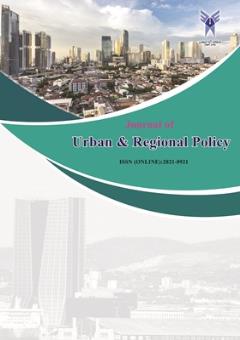سیاستگذاری ارتقاء فرآیند طراحی معماری خلاق
الموضوعات :
1 - دانشجو
الکلمات المفتاحية: سیاستگذاری, معماری خلاق, طراحی,
ملخص المقالة :
معماری خلاق، یک رویکرد خلاقانه در طراحی و ساخت ساختمانها و فضاهای داخلی است که با رویکردهای معماری سنتی بسیار متفاوت است. این رویکرد معماری، تلاش میکند تا با استفاده از روشهای نوین و خلاقانه در طراحی، ساخت و بهینه سازی فضاهای داخلی و ساختمانهای متفاوت و جذابی را ایجاد کند. این رویکرد به طراحی فضاهایی میپردازد که با استفاده از خلاقیت و نوآوری، فضاهایی با ظاهری جذاب و منحصر به فرد ایجاد میکنند. معماری خلاق بر اساس نوآوری، ابتکار و ذهن معماران و طراحان مختلف استوار است و به آنها اجازه میدهد تا طرحهای خود را با ترکیب ایدههای جدید و تکنولوژیهای پیشرفته بهبود بخشند. این رویکرد معماری، فضاهایی را بوجود میآورد که با توجه به نیازها و محدودیتهای موجود، همچنان قابلیت ارائه تجربههای منحصر به فرد و جذاب را دارند. سیاستگذاری برای ارتقاء فرآیند طراحی معماری خلاق میتواند شامل مجموعهای از استراتژیها و اقدامات باشد که به معماران و طراحان کمک میکند تا ایدههای نوآورانه و خلاقانه را در پروژههای خود به کار ببرند. ضرورت و اهمیت این پژوهش در تلاش برای روشن ساختن ارتباط بین مفاهیم ادراک شهودی و فرآیند طراحی معماری خلاق نهفته است. انتخاب موضوع و رویکرد معماری خلاق از آن جهت اهمیت دارد که تفکر خلاق یکی از پیشنیازهای ضروری برای موفقیت دانشآموختگان در طراحی و مواجهه هوشمندانه با چالشهای پیشروی آنها است. این پژوهش همچنین تلاشی است برای ارائه اصولی که به برقراری ارتباط بین مبانی ادراک شهودی و بسط خلاقیت در معماران کمک میکند، بهویژه در تمامی مراحل فرآیند طراحی معماری. با ارائه این اصول، پژوهش حاضر میکوشد تا زمینهای را برای توسعه و تقویت خلاقیت در معماران فراهم آورد. این پژوهش درصدد دستیابی به محورهای کلیدی سیاستگذاری ارتقاء فرآیند طراحی معماری خلاق میباشد.
Al-Sayed, K., Dalton, R. C., & Hölscher, C. (2010). Discursive design thinking: The role of explicit knowledge in creative architectural design reasoning. AI EDAM, 24(2), 211-230.
Aubry, A., Blein, A., & Vivant, E. (2015). The promotion of creative industries as a tool for urban planning: the case of the Territoire de la culture et de la création in Paris Region. International journal of cultural policy, 21(2), 121-138.
Casakin, H., Davidovitch, N., & Milgram, R. M. (2010). Creative thinking as a predictor of creative problem solving in architectural design students. Psychology of aesthetics, creativity, and the arts, 4(1), 31.
Casakin, H., & Wodehouse, A. (2021). A systematic review of design creativity in the architectural design studio. Buildings, 11(1), 31.
Evans, G. (2009). Creative cities, creative spaces and urban policy. Urban Studies, 46(5-6), 1003-1040.
Feng, X., Yu, L., Kong, W., & Wang, J. (2024). Frontier hotspots and trend evolution of cultural and creative design in China—an empirical research on CNKI-based bibliometrics. Library Hi Tech, 42(1), 203-226.
Goldschmidt, G. (1998). Creative architectural design: reference versus precedence. Journal of architectural and planning research, 258-270.
Gürsel Dino, İ. (2012). Creative design exploration by parametric generative systems in architecture.
Kahvecioğlu, N. P. (2007). Architectural design studio organization and creativity. A| Z ITU Journal of the Faculty of Architecture, 4(02), 6-26.
Li, P., & Li, B. (2024). Generating daylight-driven architectural design via diffusion models. arXiv preprint arXiv:2404.13353.
Li, P., Li, B., & Li, Z. (2024). Sketch-to-architecture: Generative ai-aided architectural design. arXiv preprint arXiv:2403.20186.
Lin, R., & Guo, W. (2021). Creative design of legged mobile landers with multi-loop chains based on truss-mechanism transformation method. Journal of Mechanisms and Robotics, 13(1), 011013.
Maspoli, R. (2018). Promotion and Evaluation of the Creative Industry in Inclusive Urban-Ecology Strategies. The Turin Case Study. Paper presented at the Integrated Evaluation for the Management of Contemporary Cities: Results of SIEV 2016.
Mounayar, M. (2023). Cultivating Creative Minds: The missing scale, the architecture studio’s necessary evolution. Paper presented at the Envisioning Architectural Scales in the Analogue and Virtual Representation of Architecture: Proceedings of the 16th EAEA conference.
Raulik-Murphy, G. (2010). A comparative analysis of strategies for design promotion in different national contexts. Cardiff Metropolitan University,
Rezaei, H. (2020). A Creative Cycle of Promotion: From Architectural Creativity to the Sense of Place and its Resulting Creativeness. Space Ontology International Journal, 9(4), 15-27.
Richards, G. (2020). Designing creative places: The role of creative tourism. Annals of tourism research, 85, 102922.
Sgambi, L., Kubiak, L., Basso, N., & Garavaglia, E. (2019). Active learning for the promotion of students’ creativity and critical thinking: an experience in structural courses for architecture. Archnet-IJAR: International Journal of Architectural Research, 13(2), 386-407.
Sourek, M. (2024). AI in architecture and engineering from misconceptions to game-changing prospects. Architectural Intelligence, 3(1), 4.
Umoh, A. A., Adefemi, A., Ibewe, K. I., Etukudoh, E. A., Ilojianya, V. I., & Nwokediegwu, Z. Q. S. (2024). Green architecture and energy efficiency: a review of innovative design and construction techniques. Engineering Science & Technology Journal, 5(1), 185-200.
Wang, F., Tan, R., Peng, Q., Wang, K., & Sun, J. (2024). Innovative design of multi-contradiction systems based on the function-structure model. Journal of Engineering Design, 35(5), 597-638.


